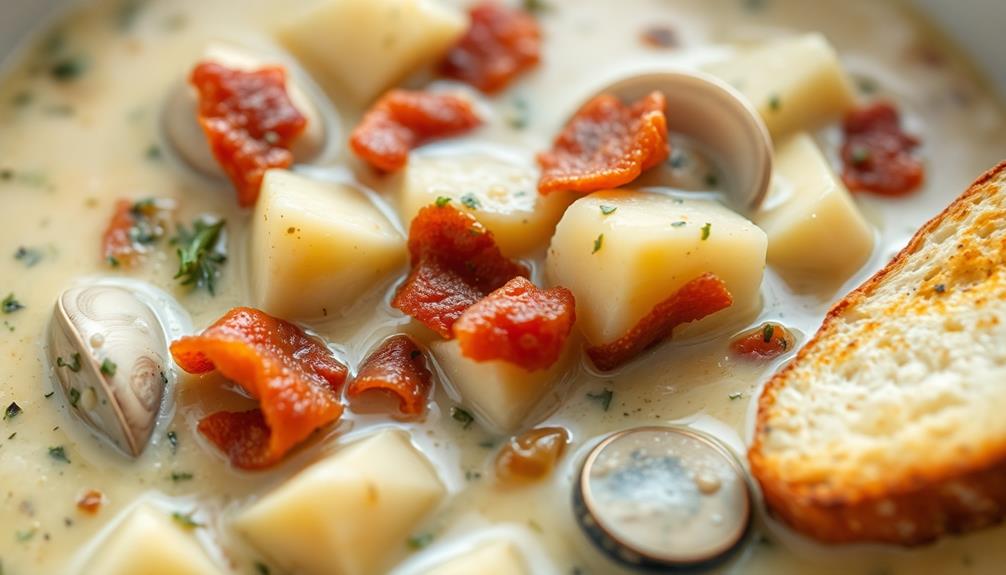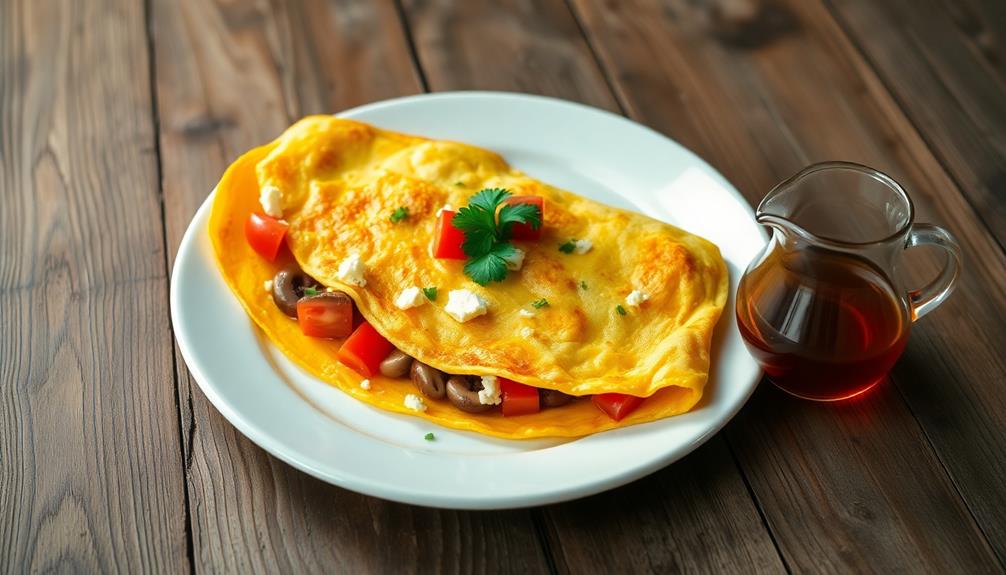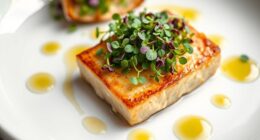Clam chowder's roots trace back to the early colonial era in the northeast United States, when coastal communities relied on abundant seafood. Crafting this cherished dish involves sautéing diced bacon until crisp, then cooking onions and celery in the flavorful fat. Next, you'll add diced potatoes and broth, letting it simmer until the potatoes are tender. Finally, you'll stir in chopped clams and cream to create a rich, comforting broth. This iconic New England recipe has evolved over generations, and making it connects you to a beloved culinary tradition – if you'd like to learn more, just keep reading.
Key Takeaways
- Clam chowder is a classic New England dish with origins tracing back to the early colonial era in the northeastern United States.
- The dish traditionally features a rich, creamy broth with potatoes, onions, celery, and an abundance of fresh clams.
- Clam chowder recipes have evolved over time, with regional variations reflecting local ingredients and cooking techniques.
- Making clam chowder involves a specific sequence of steps, including sautéing bacon, cooking vegetables, and simmering the chowder to achieve the perfect texture.
- Clam chowder is a cherished part of New England's culinary heritage, representing community, tradition, and the enjoyment of shared meals.
History
The origins of clam chowder can be traced back to the early colonial era, when coastal communities along the Northeast United States relied on the abundant seafood resources.
As these settlements grew, local cooks began experimenting with various ingredients to create hearty, satisfying meals. Clams, a plentiful and affordable ingredient, soon became a staple. Early chowder recipes often featured salted pork, onions, and potatoes, along with the fresh clams.
This simple yet flavorful dish quickly gained popularity, spreading from town to town as settlers moved inland. Throughout the 18th and 19th centuries, recipes for clam chowder evolved, incorporating regional variations and personal touches.
Today, this beloved soup remains a cherished part of New England's culinary heritage, enjoyed by people all over the world. Whether you prefer it thick and creamy or light and brothy, clam chowder continues to be a comforting, versatile, and truly iconic American dish.
Cooking Steps
Begin by gathering your ingredients. You'll need clams, potatoes, onions, celery, bacon, butter, flour, milk, and seasonings like bay leaves, thyme, and black pepper.
Start by chopping the onions, celery, and potatoes into bite-sized pieces.
Next, cook the bacon in a large pot until crispy. Remove the bacon and set it aside, leaving the bacon fat in the pot.
Add the butter and sauté the onions and celery until they're soft and fragrant. Sprinkle in the flour and stir to create a roux. Gradually pour in the milk, stirring constantly, until the mixture thickens.
Now, add the potatoes, clams, bay leaves, thyme, and black pepper. Bring the chowder to a simmer and cook until the potatoes are tender and the clams are cooked through, about 15-20 minutes.
Step 1. Sauté Diced Bacon Until Crisp
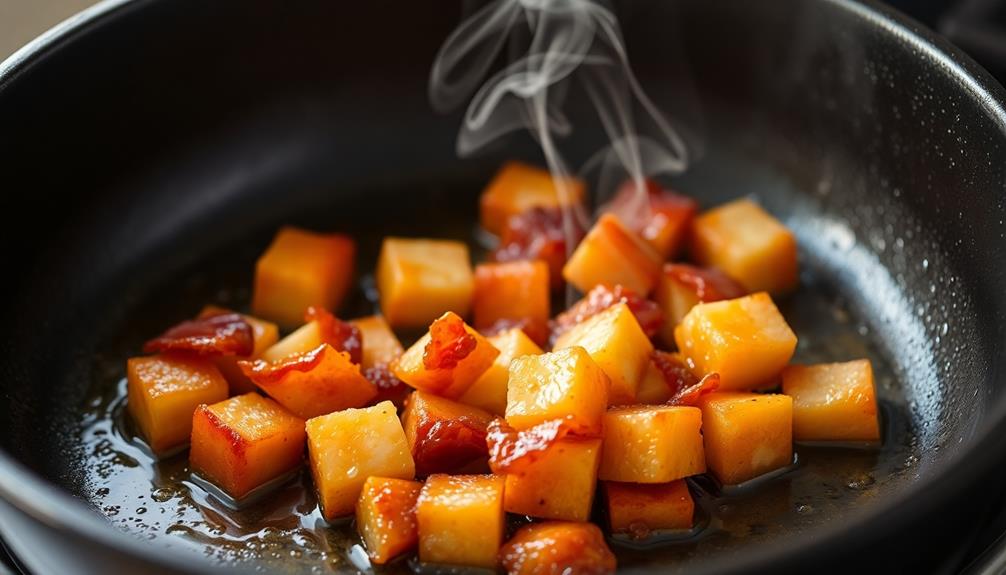
Start by sautéing the diced bacon in a large skillet over medium heat. You'll want to cook it until it's crisp and golden brown, stirring occasionally. This should take about 5-7 minutes. The bacon will release its delicious, savory fat as it cooks, which will help build the foundation of flavor for your chowder.
Once the bacon is crisp, use a slotted spoon to transfer it to a paper towel-lined plate. Leave the bacon fat in the skillet – you'll be using that to sauté the onions and other veggies next.
Be sure to keep an eye on the heat so the bacon fat doesn't burn. With the bacon out of the way, you're ready to move on to the next step in creating your homemade clam chowder. Get ready for some serious flavor-building!
Step 2. Add Chopped Onions and Celery
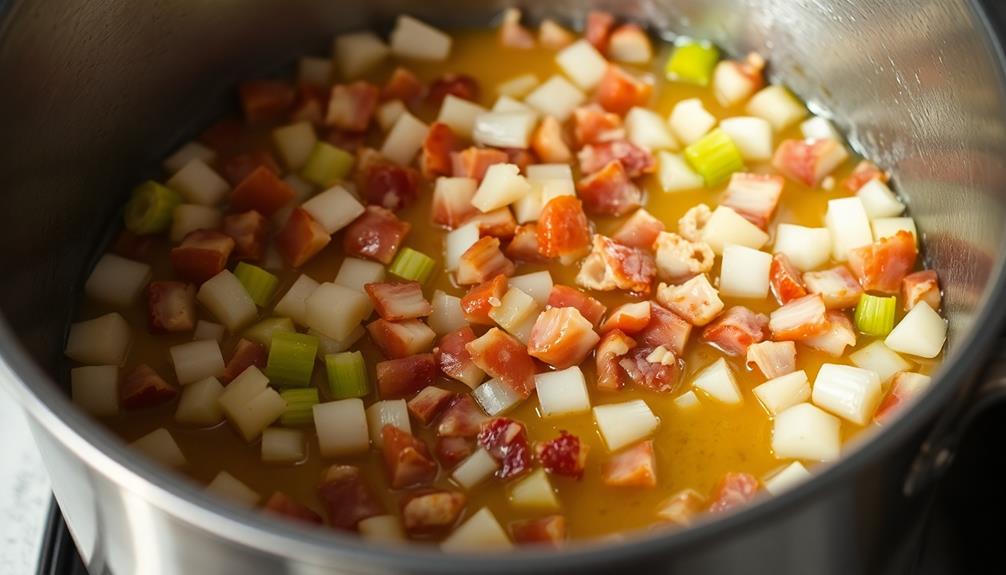
With the savory bacon fat still in the skillet, add the chopped onions and celery. The onions will sizzle and release their aromatic flavors, while the celery will add a nice crunch.
Stir the vegetables frequently, cooking them until they're soft and translucent, about 5 to 7 minutes. You'll know they're ready when the onions are lightly golden.
As the onions and celery cook, their flavors will meld together, creating a fragrant base for the chowder. The bacon bits will continue to add a delightful smoky note, complementing the sweetness of the onions.
Be sure to scrape up any browned bits on the bottom of the pan – that's where all the flavor is! Once the veggies are tender, you're ready to move on to the next step.
Get excited, because the chowder is really starting to come together now. Just a few more steps, and you'll have a steaming, comforting bowl of homemade clam chowder.
Step 3. Add Diced Potatoes and Broth
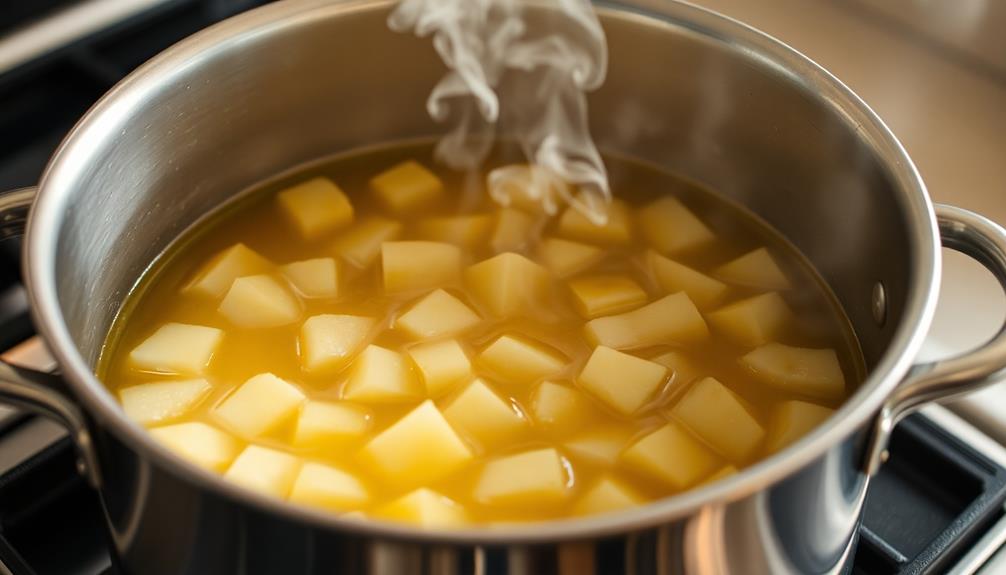
Once the onions and celery have softened, add the diced potatoes to the skillet.
You'll want to use about 2 cups of diced potatoes – russet or Yukon Gold work great. Toss the potatoes with the veggies and let them cook for 5-7 minutes, stirring occasionally, until they start to soften. After the potatoes have started to soften, sprinkle in some salt, pepper, and any other seasonings you like. Let the mixture cook for another 5-7 minutes, stirring occasionally, until the potatoes are golden brown and crispy. If you prefer a softer texture, cook for a few minutes less, or if you’re a fan of crispy tater tots, cook for a few minutes longer.
Next, pour in the broth. You can use either clam broth or chicken broth – either will work nicely.
Bring the mixture to a gentle simmer and let the potatoes finish cooking, about 10-15 minutes more. The potatoes should be tender when pierced with a fork.
Once the potatoes are cooked through, it's time to add the clams.
Stir in the chopped or minced clams and let everything simmer together for 5 more minutes. This allows the flavors to meld and the chowder to thicken up a bit.
Be sure not to overcook the clams, or they can become tough and rubbery.
Step 4. Add Clams and Cream

After the potatoes have finished cooking, it's time to add the star of the show – the clams. Carefully open the cans or bags of clams, then dump them right into the pot. Don't be afraid to use the full amount – the more clams, the better!
Stir the clams into the broth and potatoes, making sure they're evenly distributed.
Next, it's time to add the cream. Pour in the heavy cream and stir gently to combine. The cream will thicken up the chowder, making it nice and creamy. Be sure to taste as you go and adjust the seasoning if needed. A pinch more salt or pepper can really bring out the flavors.
Let the chowder simmer for a few more minutes, allowing the clams to heat through and the flavors to meld together.
Soon, you'll have a rich, comforting bowl of homemade clam chowder that's sure to impress. Ladle it up and enjoy!
Step 5. Simmer Until Potatoes Are Tender
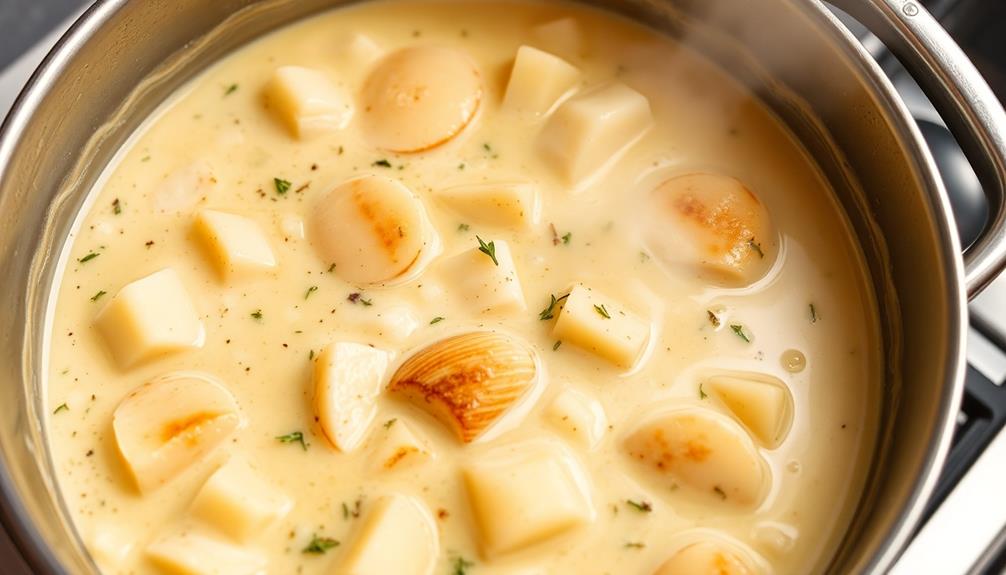
Bring the mixture to a gentle simmer and let the potatoes cook until they're fork-tender, about 15-20 minutes. You'll know they're done when you can easily slide a fork through them.
Stir the chowder occasionally to prevent the potatoes from sticking to the bottom of the pot. As the potatoes cook, the starch they release will help thicken the chowder, making it nice and creamy.
Keep an eye on the heat – you don't want the chowder to boil, or the delicate flavors might get lost. Once the potatoes are tender, you're almost ready to serve.
The chowder will have a rich, comforting texture that's perfect for a cozy meal. Just be careful not to overcook the potatoes, or they might turn mushy.
Stick to the recommended simmering time, and you'll have a delicious, hearty chowder that's sure to satisfy.
Final Thoughts
With a satisfying bowl of clam chowder in hand, you can now reflect on the journey of crafting this classic dish. From selecting the freshest clams to simmering the potatoes to perfection, you've mastered each step with care and attention.
The rich, creamy broth, the tender chunks of potato, and the plump, succulent clams all come together in a harmonious blend that warms the soul. As you savor the last spoonful, you can take pride in your culinary accomplishment.
Clam chowder is more than just a meal – it's a comforting tradition passed down through generations. By learning to make it yourself, you've not only gained a valuable skill but also connected to a deeper sense of community and heritage.
Now, whenever you crave this beloved dish, you can recreate it in your own kitchen, sharing the joy and nostalgia with family and friends. The journey of clam chowder is one of tradition, patience, and a touch of love – and you've made it your own.
Frequently Asked Questions
Can I Use Canned Clams for Clam Chowder?
Yes, you can absolutely use canned clams for your clam chowder!
Canned clams are a quick and easy way to get that delicious clam flavor in your soup. Just be sure to drain and rinse the clams before adding them to your chowder.
The canned clams will give your chowder a wonderfully briny taste that's sure to satisfy.
What Is the Difference Between New England and Manhattan Clam Chowder?
You're about to discover the delightful differences between New England and Manhattan clam chowder!
While New England chowder has a creamy, milk-based broth, Manhattan chowder has a zestier, tomato-based broth.
Both are packed with tender clams, potatoes, and veggies, but the sauces set them apart.
Whether you prefer the rich creaminess of New England or the tangy tomato kick of Manhattan, there's a chowder out there to satisfy your taste buds!
How Long Does Clam Chowder Last in the Fridge?
Clam chowder is a delicious soup that can be enjoyed for days after you make it!
When stored properly in the fridge, your leftover chowder can last 3-4 days.
Just make sure to put it in an airtight container and keep it cold.
Enjoy your tasty clam chowder over the next few days – it'll be just as yummy as when you first made it!
Can I Freeze Leftover Clam Chowder?
Yes, you can definitely freeze leftover clam chowder!
It's a great way to save those delicious flavors for later. Just make sure to let it cool completely before popping it in the freezer.
When you're ready to enjoy it again, simply thaw it in the fridge overnight and reheat it on the stove. Easy peasy!
Frozen clam chowder can last up to 3 months, so you can savor that creamy, comforting goodness anytime.
What Goes Well With Homemade Clam Chowder?
Homemade clam chowder pairs wonderfully with a variety of delightful accompaniments! You could serve it with warm, crusty bread for dipping, or top it with shredded cheddar cheese and crispy bacon bits.
For a healthier option, try a fresh green salad or steamed vegetables on the side. And don't forget the classic oyster crackers – they add a satisfying crunch to every spoonful.
The possibilities are endless, so get creative and enjoy your hearty, homemade clam chowder to the fullest!
